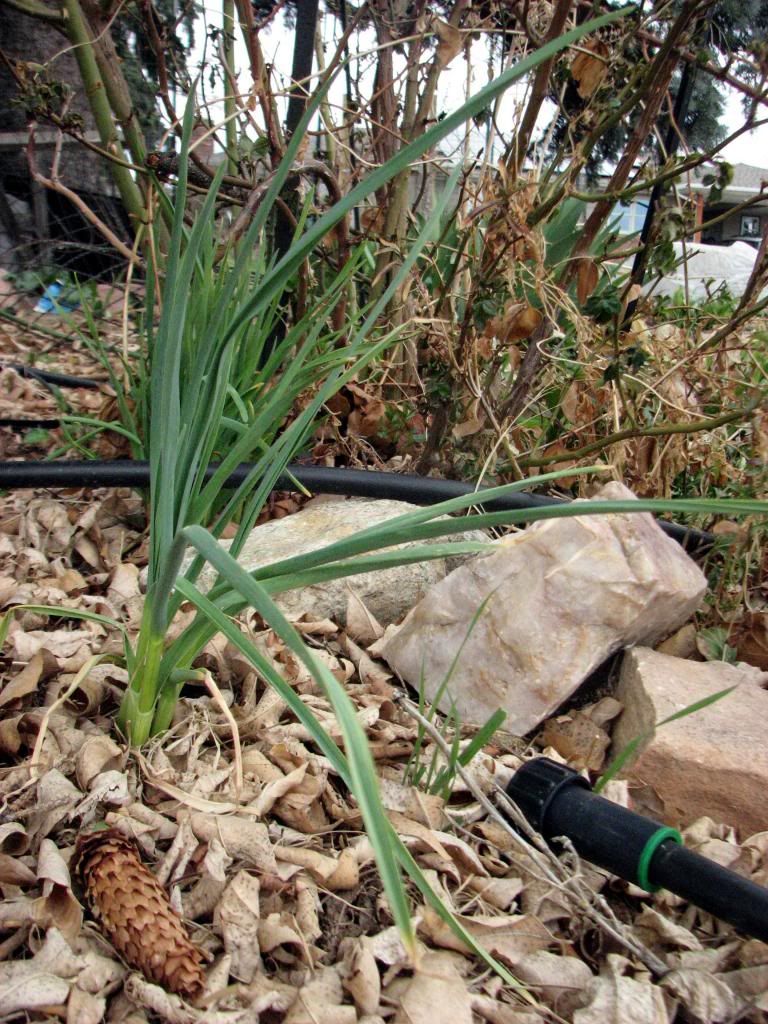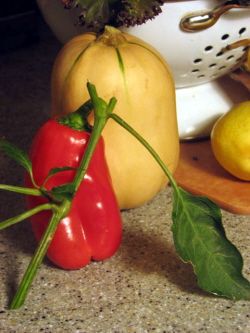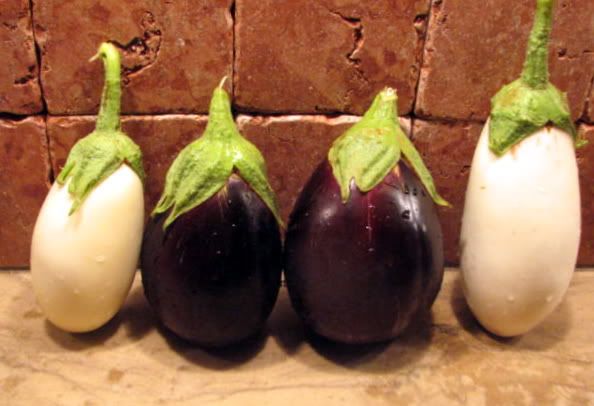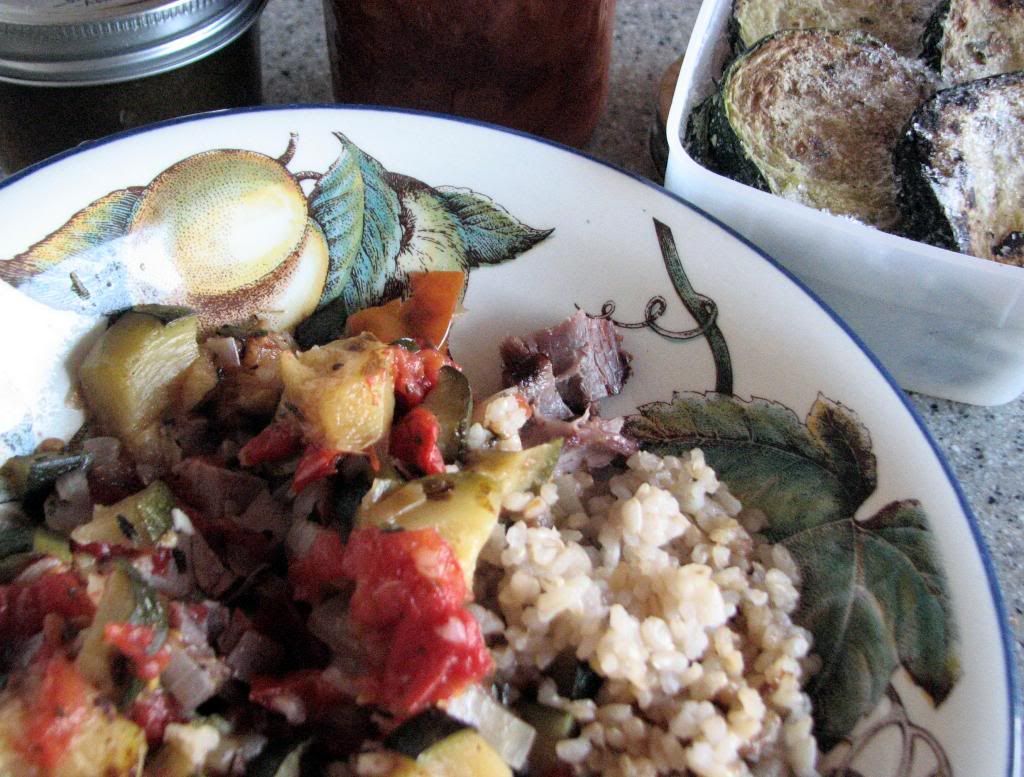Seasonal Eating = Good Eating, Automatically
I’ve been transitioning to place-based eating for close to a decade (see the previous post). With each passing year, I discover more and more amazing benefits–a whole dozen now:
- Nutritional Depth Nutrition experts continually exhort us to eat a wide variety of vegetables, in other words, a lot more than the broccoli, spinach, carrots and green salads that form the vegetable backbone of our harried lives. Happily, eating a rainbow of vegetables is automatic when the seasons dictate our vegetable choices. Without even worrying about it, we’ll eat the entire, stunning array of fruits and vegetables produced over the course of a year, from spring’s radishes, sorrel and green garlics to winter’s collards, parsnips and beets.
-

Why am I so excited by green garlics? Because I haven’t seen them for 10 months, just like the spring clothes that have been stuck in the back of my closet for months! But hurry and enjoy their mild, fresh garlic flavor; they last only a few weeks before disappearing til next year. Creative Depth Bored cooks are cooks highly susceptible to ditching the stovetop, leaving few options other than less-than-healthy readymade foods. Engaged cooks, on the other hand, have the best chance of getting real, whole foods meals on the table. Fortunately, interest and engagement are additional automatic by-products of seasonal eating, since local produce is constantly changing, season to season and even month to month. Just when tomatoes and zucchini become tiring, the winter squashes appear, adding fresh new appeal to menus. Kind of like getting out your spring clothes after a long winter.
- Connection Good health is, of course, bigger than what we eat. Among a variety of other contributors is mental comfort. Place-based eating connects us to the place we live, creating a sense of nurture, comfort and security–a good foundation for good health.
- Comforting Boundaries Speaking of comfort, many shoppers feel just the opposite as they head into a typical produce aisle. Towering stacks of produce from every corner of the globe are more likely to provoke overwhelm than comfort (proof that sheer abundance is not a sure fire solution to mealtime boredom.) Seasonal produce “limitations,” on the other hand, provide comfortable boundaries. With only 10 to 20 produce items to consider at any one time, venturing beyond our usual produce standbys is a manageable proposition.
-

From whatever is in season, simply create a pleasing color combination and pleasing flavor is practically guaranteed. Simplicity Everyone wants easy–and seasonal eating delivers here, too. Don’t ask me how the magic works, but in almost every case, whatever is in season pairs well with whatever else is in season. Winter squash and the last of the red peppers, spinach and strawberries, tomatoes and basil–great color and flavor combinations present themselves with nary a thought.
- Super Taste Speaking of flavor, it goes without saying that produce is tastiest when it’s in season and picked fresh–which is what happens with place-based eating.
- Time Savings Superior-tasting produce is produce that doesn’t need a lot of time-consuming preparation. Often, simple (and quick) is best.
-

Cookbooks often direct home cooks to peel and salt eggplant before using. This is done partially to combat bitterness, something that happens when eggplant has been around for too long, e.g., when it is shipped long distances. When using fresh-picked eggplant, however, I have never needed these time-consuming steps. Affordability Common wisdom often repeats the line about produce being prohibitively expensive. But buy in season and it can be enjoyed in affordable abundance. In fact, buy in such abundance that you can preserve some and you’ll reap the benefits of healthy produce consumption year round.
- Just What We Crave and Need On my seasonal eating journey, I’ve found it interesting, but not surprising, that the foods provided by my place fit my needs perfectly. On cold winter days, I crave energy-dense roots, potatoes and squash; I’m happy to oven roast them and heat the kitchen at the same time; I don’t mind taking time to make soups and stews and braises. Things like cucumbers and watermelon have no appeal until the hot days of summer, when they are like electrolyte-filled “sports drinks” for me. And hardly do I want to heat an oven or spend much time cooking indoors, so the ease of just quickly sauteeing zucchini, slicing a tomato and boiling corn a couple minutes suits me just fine.
-

We all know how prolific zucchini can be–and cheap–but only in August and September. So freeze some and enjoy affordable nutrition in March and April–in a quick skillet dish like this, for instance. Grateful Miracles More and more research is showing the powerful health benefits of simply being grateful. Seasonal eating is an easy pathway to a grateful life. Gradually, we get attuned to what our place is providing us now. And lo and behold, even in cold Colorado, you can’t help but notice how considerate nature is! Not only does she provide a raucous cornucopia of produce in the summer months, but as the weather cools, she delivers a huge array of winter squashes, storage fruits and root vegetables that can be stored until spring. With just a little work installing an unheated cold frame, we can grow winter greens and fresh herbs to perk up the storage vegetables. And of course, we can dry, freeze and can all sorts of fruits vegetables to last through the cold months. Even with all this abundance, however, there comes a point, around early April, when we’re about to die of boredom. And then, in a small miracle, along comes asparagus. Could you ask for more?
- Environmental Health In the quest for good health, it’s easy to get self-absorbed and forget that we can only be as healthy as the place where we live, i.e, the earth that provides the very ingredients we need for good health. Happily, plant-based eating can reverse a lot of the damage to the earth inflicted by a globalized food industry that has become singularly profit-driven. The most notable benefit of place-based eating is an enormous reduction in food miles and associated carbon costs. But localized eating also allows us to source directly and choose products grown sustainably and to support the production of vanishing plant varieties for increased biodiversity, among many other things.
- Economic Health In a similar vein, place-based eating allows us to support a diverse range of growers, from micro to medium-sized operations that not only strengthen the fabric of our economy. The diversity and distribution they bring to the country also serve as a vital–but surprisingly overlooked component of true national security.
With so many advantages and benefits, why would we possibly opt for a limited repertoire of subpar, over-priced produce requiring extra preparation? Interesting question with definitely doable solutions. Read the next post. . .
1 thought on “Eating Well–Without Trying So Hard or Worrying So Much (part 2)”